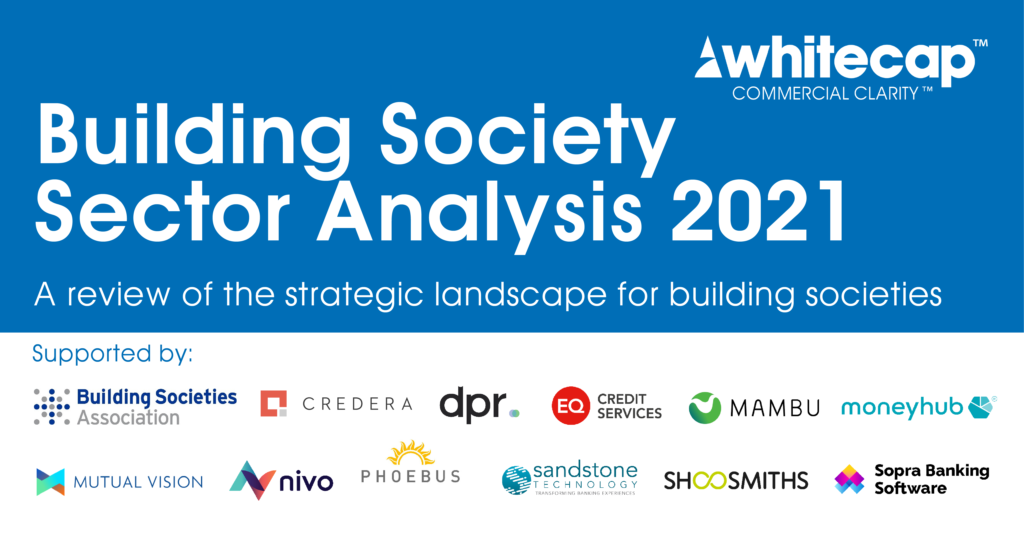In this piece, Luke Freeman, Director at Whitecap Consulting, discusses the key report findings relating to strategy and how the sector dynamics and heterogeneity of building societies have an influence on strategic focus.
In addition to covering Whitecap’s four key findings in relation to strategy, Luke also highlights a set of key questions for building societies to ask themselves when considering their strategy.
 The analysis underpinning the report was conducted over a 6-month period and included interviews with 33 of the 43 building society CEOs, as well as various supporting research and an online survey that was issued to the sector. Whitecap’s four key findings in respect of strategy were:
The analysis underpinning the report was conducted over a 6-month period and included interviews with 33 of the 43 building society CEOs, as well as various supporting research and an online survey that was issued to the sector. Whitecap’s four key findings in respect of strategy were:
The sector is not homogenous, and societies adopt a range of different strategies and business models
When conducting our ecosystem analysis, we observed that the sector is not homogenous; each society has a distinct mix of strategies that are based upon the individuality of that society and the long-term ambitions of its leadership team.
While there is a common core focus on mortgages and savings, the strategies of individual societies can vary greatly. For example, our online survey revealed that 81% of societies consider themselves to be assets/lending led whilst 19% consider themselves to be liabilities/savings led.
Looking beyond these core markets, there are also many examples of building societies diversifying their revenue streams through subsidiaries, joint ventures, investments and commercial partnerships. Within mortgages and savings, there are a wide range of examples whereby the strategic focus of the building societies reflects heterogeneity. For instance, of the building society CEOs interviewed for the research:
- 36% consider their society to be primarily serving national lending and savings markets
- 27% are focused on national lending markets and regional savings markets
- 18% are pursuing regional lending and savings markets
- 9% are focused on regional lending markets and national savings markets
Growth is not always viewed as a primary indicator of success in the sector
The mutual model means that building societies are answerable to their members and deliver value directly through the provision of their products and services. This is in contrast to privately owned or publicly listed organisations who are answerable to shareholders and who deliver value to them through the generation of dividend and / or the growth in the notional value of the whole enterprise. In that shareholder model ongoing growth of the business is critical to the mission.
In the building society sector, in contrast, growth is not necessarily a primary indicator of success. Growth may be seen as desirable to help ensure long- term sustainability, and as an indicator of competitive strength but unlike those shareholder owned organisations that are likely to be managed in order to grow enterprise value, ongoing growth and profit maximisation are not key drivers in their own right.
This can especially be seen when comparing the decision-making dynamics of building societies to banks as we observed a strong focus on sustainability and ensuring the society would be there for future generations rather than a desire to achieve ambitious growth targets.
The need to evolve digitally is acknowledged as a priority, but not necessarily an immediate one
Research into the adoption of internet banking reveals that the highest proportion of users are those aged 18 – 24 (91%) whilst of those that represent the majority of building society customers (aged 55+), the uptake of internet banking is also still noticeable at 43%. This data suggests that overall, society is moving towards digital but at a faster pace amongst the younger demographic.
We found that the actions of building societies are in accordance with this as the sector acknowledges the need to increase their digital capabilities in order to be sustainable however, because digital adoption is slower amongst their core member base (aged 55+), it is not an immediate imperative.
With regards to savings, the typical member profile tends to skew towards the over 50’s, and often have large savings deposits, reflecting the distribution of cash wealth in wider society. Conversely, there is a younger generation who are digitally native, unaware of the historic context of building societies and who have little or no savings. Although this generation may not require the services of a building society right now, eventually they will become the target market of the sector and because their expectations and behaviours are so different to previous generations, understanding their needs and adapting the proposition accordingly may determine which building societies successfully establish long-term sustainability.
Communication and relationships between societies are strong, but collaboration on joint business initiatives is rare
The opportunity for collaboration in the sector is an area of interest not only to building societies, but also to providers to the sector who see an opportunity to deliver collective solutions. It is important to note that societies can and would only collaborate on non-competitive matters permitted under competition law. The opportunity for more formalised collaboration within the sector is acknowledged but is not currently prevalent in the sector, and whilst there are many areas where societies seek the same services / technology from the same suppliers, they will usually contract on an individual basis. According to our online survey, building societies consider each other to be core competition within both the mainstream (77%) and specialist (80%) mortgage markets which could be preventing the sector from engaging in collaboration, knowledge transfer and resource sharing.
Key questions for building societies in respect of strategy:
-
- Are you able to succinctly describe your organisation’s purpose. E.g. how you will make your members’ lives better in the future?
- Do you have a clear view of what you want the shape and size of your member and customer ‘portfolio’ to look like over various time-horizons into the future?
- Do you have a clear view of the promises you will need to make and keep to current and prospective customers in order to build / maintain that portfolio and to deliver on your purpose?
- Do you have a clear view of what financial performance metrics you need to achieve in order to have confidence in your long- term sustainability?
- Do you have a clear view of the operational and behavioural competencies you will need in order to deliver the above outcomes?
- Are you clear on the nature and magnitude of any gaps between your target state and your current state?
- Have you costed, prioritised, and sequenced the actions you need to take to make meaningful progress towards your target state?
The related topics of strategy, mutuality and technology are covered in more detail in the report, which you can download the report via the link below.
Background to report:
Building Society Sector Analysis 2021 – A review of the strategic landscape for building societies
The research underpinning the report was conducted by Whitecap Consulting in partnership with the BSA, and involved a quantitative data analysis of all 43 building societies, interviews with 33 of the building society CEOs, and an online survey which received a total of 134 respondents.
This analysis and report was funded through sponsorship from a number of industry stakeholders including: Credera, DPR, EQ Credit Services, Mambu, Moneyhub, Mutual Vision, Nivo, Sandstone Technology, Sopra Banking Software, Shoosmiths, and Phoebus Software.
The eight blogs in this series will focus on key topics addressed in the research: FinTech, Strategy, Mutuality, Regionality, Technology, Mortgages, Savings, and Open Banking.
Useful links:
Building Society Sector Analysis 2021
Watch the report launch webinar
